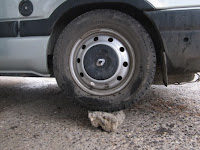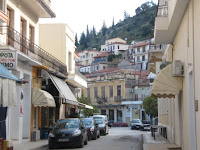Imagine the bottom of the Peloponnese as three fingers pointing south into the sea. The Máni is the middle of these fingers, and in a way it has been sticking that finger up at the rest of the world for centuries. It’s a rugged and austere land, with fairly inaccessible terrain either side of its mountainous spine at the end of the Taíyetos range. The peninsula itself forms the Mésa (Inner) Máni and has the harshest terrain, while the greener Exo (Outer) Máni extends to the north, between the mountains and the Gulf of Messinia. At one time many Máni villages could be reached only by sea or pack-horse, but the building of new roads in the 1960s opened up the region and it seems as if tourists have been the final invaders, conquering the area where others before them failed. Mind you, the route we took from Yíthio (Gythio/Gytheio/Gytheion) towards Kalamáta in early January at times seemed little more than a winding village street rather than the region’s main road. It was a route which took us through a landscape dotted with ruined tower houses and covered variously with rough scrubby bushes or endless olive groves, all running down to precipitous cliffs which hang over the clear, blue sea.
The Ottoman empire only ever held the Máni with a sort of light touch. Maniots would say they were never subdued by the Turks, but it seems more that as long as the area paid its dues the Turks never really bothered to take on the locals. The Máni became a stronghold of fierce warrior clans, and the ruling families began building fortified tower houses, for which the area is now renowned. These houses served as strongholds during the unremitting, savage blood-feuds between rival families, where vendettas could last for decades, while the menfolk, holed up in their towers, lobbed rocks and fired cannons at their neighbours. This warlike nature was put to good use in the shaping of modern Greece as the Mániot clans were prominent in the rebellions against the Turks in the 1820s. They still proved troublesome in the new Greece however, and assassinated its first president in Náfplio some years later.
Typical Máni – Flomohóri village and Kótronas Bay
On the 10th of January we made our way from Yíthio down the steep eastern flank of the Máni peninsula, where the stony land drops sharply from the mountains to the sea. On this side, the villages we encountered were quiet, with few inhabitants and with many of the houses abandoned. The arid hillsides surrounding them were formed into tiers of stone-walled terracing, laboriously created out of the rock. These terraces give the impression that agriculture here has always been of a marginal nature, and the tiny fields seem now to be used by just a scattering of cows and goats. On the road down to Pórto Káyio and Marmári however, we also came across a trio of very tame black pigs who wandered across the road and rubbed their mud all over the sides of our recently cleaned van.
Stone terracing and pigs near Marmári
We revisited Cape Ténaro (Tenaron, Tainaron), which legend has as one of the entrances into the underworld. Signposted here is the dramatic sounding “Death Oracle”, but really there’s not much more to see than a small shrine to Poseidon and a lighthouse. At 36˚24’ 8.5” north, it was the most southerly point we expect to visit on this trip, and came five months and a day after leaving our most northerly point, on a Norwegian fjord off the road to the North Cape. We stopped for the night on a small parking space designated for motorhomes, tucked away at the entrance to the village of Marmári, from where we enjoyed watching the many large ships pass by, and the pretty pink skies over the sea.
Pórto Káyio, Marmári and road to Cape Ténaro
Chocks away! We solve the problem of levelling and Princess Hale can now always sleep “head up”!
Marmári, like so many villages in the area, was obviously a place of some tourism in the summer, but it is not over-developed. Of course, in January much of the place was shut up and this whole stretch of coast has many empty beaches, closed tavernas and plenty of beautiful places that are ideal for wild camping. In many of the villages tower houses have been restored, presumably as second homes for Greeks, Germans, Dutch and Brits, but there are many more that remain in ruins, ripe for development. On leaving Marmárí on Tuesday 11th January, we visited Váthia, which is among the prettiest of these tower house villages, and scrambled happily amongst the ruins and on the steep, overgrown stone path that was the village street. It was quite a shock to come across the odd place which was obviously still lived in, and even more surprising to see a little old lady walking past with a bundle of twigs on her back. She wanted to chat about Charlie and did not seem to care that I was speaking in a foreign language.
Váthía
We stopped for lunch at Yeroliménas (Gerolimenas, Gerolimin), a small fishing village we had stayed at two years ago. It’s a very pretty place with a mix of sea-front tavernas, guest houses and apartments in varying states of use, dereliction and restoration. It was virtually empty, bar a few guys at a couple of tavernas and a British couple who have retired out here. However, from the number of tavernas, it must be busy in the summer months. We had some small fish, kotsomoúra which are like mini-red mullet, and then moved on over the headland towards Cape Tigáni, where we hoped to see the ruins of a Frankish castle and a church. We never did get down to the headland though, and instead headed round the bay to the tiny harbour at Mézapos, where we camped up for the night by the lower beach, having failed completely (again) to catch any fish from the harbour walls. We had a roaring fire on the secluded white pebbled beach – great for cooking on and then sitting beside afterwards, drinking wine and star-gazing.
Mézapos harbour and beach
On the hillside above the beach was a small chapel, which we visited the next morning. Like many such places, it was still in use. In the sanctuary a candle was alight, its spluttering flame shedding almost no light in the smoke darkened interior. On the mildewed walls were the remains of frescoes, and icons of St Nicholas hung among damp and fading Christmas cards sent from other churches. There are a great many similar small domed churches peppering the landscape, amid olive groves, in villages and high on rocky outcrops at the top of hills or the points of headlands. Some have lovely Byzantine style architecture, and are well worth viewing, if only from the outside. If you’re lucky enough to find them open you might be rewarded with frescoes, or more likely bits of frescoes, restored from beneath later whitewash. Most of these chapels are still used, as shown by the lit oil lamps and the stubs of devotional candles sitting in tiny tin sand trays.
Chapels – Mézapos, Nomitsí, another one at Nomitsí, one near Ayiós Kiprianós, one on the hillside between Lagáda and Trahíla, Nomitsí again.
We continued round the coast, past Pýrgos Diroú, where we passed up on the chance to visit the cave system which draws tourists to this area. Caves just don’t “do it” for us, even with the lure of a boat ride and spectacular beauty, but each to their own. I guess mildewed frescoes would leave many cold, where we actively seek them out! The little town of Areópoli appealed to us though, with food shops, tavernas and pleasantly restored streets. Actually, it had several good butchers’ shops, where we bought more of the local sausage, which has a delicious tangy flavour, enhanced by the addition of orange peel. We also bought some of the local honey, which is meant to be extra special. We’ll let you know when we actually open it, but we’re still making our way through our van-made marmalade. There are lines of bee-hives just about everywhere on the Máni’s hillsides, though there are throughout most of Greece so I’m not sure why the Máni’s honey is famed. It all added up though and we spent a small fortune in Areópoli’s food shops (about 75 euros), stocking up our depleted fridge and near empty larder (well, food shelf in a tiny cupboard). The cost brought it home to us that Greece these days is not particularly cheap compared to the UK.
Areópoli
From Areópoli we drove north through the Exo Máni, on roads which thread through steep sided hills and over deep gorges, none of which contained a drop of water, let alone a gushing watercourse. Presumably, these must have been cut by seasonal torrents cascading down the mountain. Villages clung precipitously to hillsides, but with fewer tower houses now, although they are increasing in number in some places, as holiday developments have been built in local stone to resemble these medieval buildings. We even spotted the odd 1960s house being clad with stone to make it what, more Máni? More saleable? These developments made us sure that we would not want to be here during the height of the season. We like it all looking a bit wild and uncluttered. Much of the area that is not rock, or village, or holiday development, is given over to olive groves. Trees were still being harvested in mid-January, with sacks of olives waiting by the roadside at the end of the day for collection and pressing, which apparently has to be done on the day of picking for a really good quality oil.
Éxo Máni – sunset at Trahíla, and architectural oddity in Lagáda
We were not sure if the weather we had been enjoying since New Year was typical. Daily temperatures had regularly hit 16 to 20 degrees, which made us want to linger in some of our beautiful camping spots. The climate was so mild during our time here that it seemed to be heralding the start of spring, though Brits living out here have on several occasions warned us that February can be very cold and they’ve had snow at the start of March. The Éxo Máni is greener and generally a more fertile area than the rest of the peninsula, and we were pleasantly surprised to find some beautiful flowers growing on the mountain slopes and sides of roads. Stunning red anemones and delicate purple irises were just two varieties we’ve never before encountered growing wild and certainly did not expect to see in the middle of winter.
Wild flowers - anemones and dwarf irises
On the coast north of Areópoli we found an idyllic spot just outside the village of Trahíla (Trachila), where the road finally petered out on the cliff top. So nice in fact that we stayed there for three nights. On one day I (Rob) attempted to follow a signposted route over footpaths up to the village of Lagáda (Langada), a short distance inland but hundreds of meters higher up. It was certainly pretty, and a memorable walk on such a beautiful day, but without any waymarking en route I found myself hacking through overgrown scrub and came back covered in scratches. On the next day we did actually leave, but as we only got some 10km down the coast we decided to come back for another night.
Around Trahíla
The attractive coastal villages from here on, such as Ayios Nikólaos, Stoúpa and Kardamíli (Kardamyli, Kardhamili) formed a little pocket of ex-pat land, and we started to hear English and German at every café, not to mention the biggest concentration of UK-registered cars since the migrant-worker villages in Romania. An upside was that we found a day-old copy of the Guardian in a shop, something not even Yíthio or Náfplio had been able to offer.
Stoúpa and Kardamíli old town
Looking for a place to stop north of Kardamíli on Saturday 15th January, we turned off onto a maze of olive-growers’ tracks on the otherwise roadless Cape Koúrtissa, and after bumping for ages down steep and narrow dirt paths, we stopped by a little chapel amongst the scrub and olive plantations. It was a stroke of luck for it was a beautiful and isolated site, high above the sea and with views right down the western side of the Máni as far as Cape Tigáni, as well as the snowy tip of the Taíyetos behind. We ended up staying for the whole of Sunday, and saw only one other soul, a hunter out shooting birds. He was a friendly chap, but my (Rob’s) capacity for chit-chat in Greek is basic to say the least, and we left it at general pleasantries although he was concerned about the lump on Charlie’s leg (which is unsightly, but not likely to be a health risk according to our vet).
Cape Koúrtissa – Charlie’s gone native and sprawls out like this at just about every camping spot now.
On Monday 16th January we moved on, heading round the round the coast to Kalamáta, thus leaving the Máni.
Some people might tow a Smart car, but with our Byzantine chapel we can park on any village square in Greece!


























































